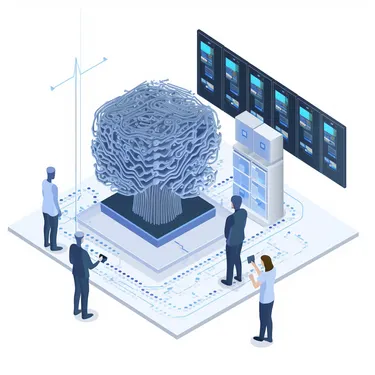Introduction
Innovation when the toilet paper runs out
What can you do with an empty toilet paper roll? Growing up, I’d make it into a telescope. Wrap some aluminum foil around it, and it becomes a spaceship.
Then, when I was ten, I wrapped some copper wire around an empty roll and made it into a crystal radio. I was in awe. I’ll always remember the thrill of hearing distant voices on my homemade radio. I’d listen to my radio at night, dreaming of endless possibilities.
Yes, I was a geek who grew up poor. Technology fascinated me, and I had to be creative to fuel my curiosity. Growing up, I remember seeing the first moon landing, the first video game, the personal computer, the birth of the web, and smartphones.
So it’s not a stretch that I ended up selling technology for my career—working for notable companies with cutting-edge tech—and helping others adopt its transformative power.

With a rich set of experiences around innovation, I confess that I’ve never been more amazed by technology than I am today.
(NOTE: The photos in this blog, and the voice below are AI-generated.)
Discovering generative AI
Today, it’s different.
Even though I enjoy reminiscing about the wonder-filled era of video games, I am fascinated by what is possible and what lies ahead.
My business acumen, failures, and successes have shaped a more cautious version of me. I’ve seen tech that was no more than a “flash in the pan.” And now, I’ve witnessed generative AI (the G in GPT) and was an early adopter of Open AI’s Chat-GPT.
I must have spent three days without sleep, testing the boundaries of GPT when I got access in the fall.

With GPT and more complex models, we have a type of technology I’ve never seen. It’s unique and different and will shape the future of selling and everyday life. It’s as transformative as the lightbulb, electricity in general, or humans’ harnessing of fire.
The transformative potential of AI
Go ahead and chuckle right about now. That’s your inner cynic, designed to be skeptical of platitudes and empty promises.
These are the staples of modern living. We are drowning in information, and our BS detectors are in overdrive. Anything that sounds too good to be true must have a catch—a dark secret or a fatal flaw.
AI is not immune to any of these, and I’ll share a balanced view of this landscape and its impacts.
Get ready to harness the potential of this revolutionary technology. Join me as we navigate the wonder and practicality of AI for sales forecasting and revenue generation.
Understanding Technology Adoption
Understanding how people adopt technology is helpful before we jump into the topic.
Selling is all about people.
Moore’s Law and its Implications
Moore’s Law originated with Intel co-founder and computer scientist Gordon Moore in 1965. Moore claimed that a microchip’s transistor count doubles every two years, increasing computing capability.
His findings have accurately predicted the rapid advancement of technology. While the underpinning technologies may change, Moore’s Law indicates how breakneck technology adoption happens.
“Crossing the Chasm” by Geoffrey A. Moore (not Gordon) explains these adoption tempos. He applies a salesperson’s customer interaction history and marketing savvy to the “Diffusion of innovations” theory. Moore created a technology adoption life cycle, which became vital to understanding the uptake of innovation in tech sales. Each stage represents a type of person in the technology adoption life or sales cycle: early adopters, early majority, late majority, and laggards.
Looking at Moore’s Law and “Crossing the Chasm,” you’ll notice that early adopters will embrace AI quickly but account for the smallest group.
The “chasm” between early adopters and the early majority is time-based. Each group has different needs and expectations across the technology adoption life cycle.
Sales teams must tailor how they meet their customers‘ needs and outcomes. AI doesn’t change this at all – it just gives it a boost to do it faster and more completely.
The Innovation Adoption Curve
Speaking of the adoption curve, you must be under a rock if you have yet to hear how fast Chat-GPT has captivated the world. It crossed 1 million users in its first five days and, as of May 2023, had more than 1.16 billion users.
Bank of America, like many others, says AI is having an “iPhone moment” with an economic impact of $15.7 trillion in 7 years.
AI is here to stay. It’s the worst it will ever be, and now we will traverse the chasm at warp speed.
Resistance to technology and the Luddite mindset
It always surprises me when I come across people who seem resistant to embracing AI, particularly Chat GPT.
When I tell them that this is one of the most transformational events in human history, their eyes tend to glaze over. They often dismiss it as another glorified writing app that rehashes old content, akin to a spin rewriter. I feel that they might not grasp its impact.
But the truth is that it can potentially revolutionize AI in sales, marketing, and many other aspects of our lives. Adopting a Luddite mindset and resisting technology can have real consequences.
The Luddites were a group of English textile workers in the early 19th century who opposed technological advancements, fearing they would take away their jobs. The Luddites were a critical voice, but they couldn’t stop progress, which robbed them of a better life.
While many of their concerns were accurate, history has shown that you can stay relevant and competitive with AI technology only if you prepare.
Sales and marketing teams that ignore AI will need help to keep up with the competition. The industry is changing, and those with high-performing teams who harness the power of AI will likely outperform their peers who cling to outdated methods.
Let’s learn to harness artificial intelligence and its potential to become sales tools to shape the future of sales and marketing and stay at the forefront of our industry.
You’ve got this.
AI in Sales: Fundamentals
Just because you hear a new AI story daily doesn’t mean all this is new.
Here are a few ways to better understand AI.
Understanding AI fundamentals
While the roots of AI are woven into technology history, the present calls for everyone to learn more. Here are some AI fundamentals.
Machine learning tools
At the heart of machine learning is the ability of a computer (machine) to crunch the data and reach an outcome faster than other methods. ML (or machine learning for short) builds better demand forecasts, analyzes complex data, can help personalize data, and increase the speed of getting results.
The steps for a machine to do this are:
1. give it data
2. build a model
3. train the model
4. deploy & refine the model
AI vision
Remember that first webcam? It worked if the camera could distinguish that you were in front of it. Today, cameras are smaller and more advanced.
Tesla cars have sidepost cameras that watch for harmful threats and turn on to record the first sign of danger. AI can identify pictures and objects.
At Microsoft, where I work, one of our engineers even created synthetic vision glasses years ago to improve his quality of life as a blind person. It was amazing to witness his resourcefulness in leveraging technology as an asset to enhance life.
It’s one of the things I love about retired football player Steve Gleason. Technology makes him able to interact with his world, despite battling ALS.
anomaly detection
As computer cameras have gone beyond 4K in the palm of your hand, it’s like washing a set of dirty windows—the world suddenly becomes more visible. Anomaly detection has become helpful in medicine, searching images for signs of early cancer, and companies identifying and responding to global security threats.
Even your doorbell can tell if it’s a person or a package at your front door. It can be effective for sales teams to use anomaly detection to look for CRM opportunities that must follow your standard process or pricing guidance.
natural language processing (NLP)
Natural language processing bridges what we say, converting it into machine understanding. If you’ve used Siri, Alexa, or Cortana assistants, you’re familiar with this type of conversational AI.
Conversational artificial intelligence for sales is any tool or software designed to make people feel human.
Conversation AI for sales uses NLP technology to capture and analyze customer data via text/voice interfaces. You can detect customer sentiment and even see if your offers are landing.
Common Challenges in Sales Teams
A recent Salesforce State of Sales survey shows that sales professionals spend only 28% of their week selling. Salespeople want to spend more time selling, but many struggle with the administrivia that weighs them down. Time spent not-selling means your sales team, a highly paid asset, isn’t generating you any revenue. Many teams have the appearance of activity – lots of it spent creating proposals, offers, building pitch decks, and responding to inquiries.
Fix these elements in your sales model, and you will see results.
Another common challenge in your sales model may be that your sales leaders are unadaptable (“this is how we’ve always done it”) or one-dimensional. New technologies like AI offer possibilities to increase agility and open new doors to more significant revenue generation and customer satisfaction. But only if you enroll them and help them be productive too.
Here’s a quote from the AI at Eleven Labs, “Once a new technology rolls over you, if you’re not part of the steamroller, you’re part of the road.” I’d rather be the steamroller. What about you? What do you say we buckle up and press on? Let’s go steamroller!

Reason #1 – Use AI as a Force Multiplier
I learned about force multipliers in the military, a concept that has migrated well into my business career. A force multiplier significantly increases the team’s potential and stacks the odds of success in your favor. It can be as simple as ensuring your team has hand warmers to operate machinery more efficiently. It can be a complex piece of machinery that no one can access, giving you an advantage.
Create a digital double
Text-to-speech has made rapid advancements thanks to AI. Today, you can either select a digital avatar or create your own in your likeness. It’s simple to do, but takes time to train the model.
This new digital double will say anything you provide a script for. To see a compelling demo of this, check out Synthesia to see how far AI-generated text-to-video has developed.
Here are a few possibilities for leveraging this to help align your sellers to the most important and strategic engagements.
- Your new training video,
- an introduction to a new product,
- a virtual sales video pitch, or
- an onboarding video.
You decide. Think of all the activities your sellers might do that need to leverage their highest potential. You also have to think about how your customers feel about interacting with an AI version of your company.
Let’s say you leverage AI to help onboard customers, then be transparent and say – “We’ve created an AI-generated video to help you get started. Remember, you can connect with a live person anytime by pressing the button below.”
I’d love to see an AI face next to heaps of support content when searching for something. You can have someone read to you while searching on other screens.
Let’s say you’ve made your double. AI can also clone your voice, so the avatar looks and sounds like you. At the top of this blog, that’s the cloned voice I created. This technology is impressive and enough to make Max Headroom jealous.
Do more routine tasks with ease
I still remember what it was like to use a typewriter. I had a typing class required in high school and, at the same time, was learning BASIC on an Apple 2+. Content creation didn’t go away. It became more pervasive.
Creativity and idea generation will rise in a new era of AI, making routine tasks like meeting summaries, agendas, and follow-up emails something we do in a few seconds instead of multiple minutes.
You can do amazing things with ChatGPT. That genie’s already out of the bottle.
Another model in development by Adept called ACT-1 can interact with everything on your computer as if you were using the mouse and keyboard to operate it. It goes beyond declarative commands because you can tell the AI the outcome, and it will figure out how to get there.
Need to update your CRM? What about that TPS report? ACT-1 will be able to do anything you can do, but probably better.
Here’s a geek hack: Ask ChatGPT4 to create a presentation and output the format in Visual Basic. Open the VB editor in PowerPoint, paste it in, and voila! Your idea to PowerPoint in 90 seconds.
And if you are prospecting from your CRM, Seemless AI makes it seamless. You can be far more productive with rich information waiting for you to hover over it. If you have ever thought of leaving your flow to investigate deeper details about your prospects or customers, Seemless makes it simple. Here’s an invitation to check it out.
How about asking the office spreadsheet guru how to do complex formulas? No need to admit your defeat; AI can do it faster and go from problem to formula in seconds. It’s not what’s coming, it’s what’s here right now. I’ve seen a handful of Excel AI services that can help.
And Microsoft’s Co-Pilot will certainly change how you look at productivity.
Here’s one sure to blow your mind: Open AI’s Whisper is a text-to-speech system in training. It’s better than any computer you’ve conversed with – ever. And it’s multilingual. Will it one day update your CRM while you drive your AI-powered car, chat about your sales meetings, and update your CRM while drinking a latte? Bet on it!
And if you tune into the leaders at humane.ai, they see a future where the computer is no longer something with a screen and typewriter. Instead, the computer is invisible, projecting holograms like those in Star Trek onto your hand or other objects around you.
The future computed might be a patchwork of seamless, interconnected experiences—except your AI companion can recite the corpus of human intelligence in a few seconds.
Unlock Unparalleled Market Insights with AI-Powered Research
Fail to plan, plan to fail. Preparing for sales calls separates professionals from amateurs.
The degree to which elite sellers plan is directly related to how much their customers trust and let them into their business. Salespeople should behave as if they have a seat in the executive boardroom. The degree to which you understand their business and solve problems will take you far.
The great news is that business insight tools in sales are familiar. Companies like Affinity, Crynchbase, Clearbit, and many financial databases already do an excellent job informing us about customers. How AI shares new information that is off your radar is new.
Here are a few examples:
- Understand key trends in industries you work with📊. Use AI to identify industry-relevant data to create targeted messaging and offers more likely to resonate with your customer.
- Share a few insights from your customer’s market, then ask it to see similarities and areas of uniqueness. Start thinking like your customer, and ask ChatGPT to help you develop more empathetic and customer-focused approaches..
MarketMuse is your secret marketing weapon. It analyzes your assets and explores how they align with your customers and potential customers. It’s a perfect example of where AI is helping raise the bar. Customers will no doubt have more content to sift through in our AI future, but there is now no excuse for poor positioning.
A complex customer has complex relationships. Sellers have often used networking skills and artificial intelligence in sales tools to develop their network around a customer to get deeper insights or build alliances.
With AI, this is mapped out. AI seeks this information out and displays it graphically. You can visualize connections like never before.
If you ask yourself, “Wow, which of my competitors uses these tools?”
or “Maybe we have time before this AI thing catches on.”
Honestly, time’s up.
The best strategy is to jump in, see who’s in the pool, and hope it’s not a shark about to bite your business model.
Reason #2 – Leverage AI as a Sales Performance Coach
When I started writing my book almost four years ago, I saw the digitization trend of sales performance management.
Today, it’s here.
Imagine having a sales coach available 24/7, never taking a coffee break, who can crunch massive amounts of data in seconds to offer razor-sharp insights.
Sounds too good to be true?
Well, brace yourselves because AI is here to fill that role and elevate your team’s sales performance to the next level.
As a sales manager and performance coach, AI is like that wise mentor who’s always on the ball, never misses a beat, and doesn’t bother with small talk or motivational posters.
Instead, it analyzes your sales data, spots patterns, and offers precise suggestions to improve your performance.
Need to close that deal faster?
AI’s got you covered.
Struggling to prioritize leads? AI’s already sorted them out for you.
The best part? AI doesn’t have a favorite sales rep, so there’s no favoritism or bias here. It’s all about cold, complex data and actionable insights to help everyone on your sales team to succeed.
So embrace this tireless coach, and watch your sales game transform before your eyes. And don’t worry. AI won’t take offense if you don’t invite it to the office holiday party.
Reason #3 – Let AI Help You Target Customers with Precision
Picture this: you’re on a quest to find the perfect customers, but instead of a map and compass, you’ve got AI by your side.
With its unparalleled ability to analyze data, AI can pinpoint your ideal customers faster than you can say “target market.”
Say goodbye to the days of blindly casting a wide net, hoping to reel in some high-quality leads.
AI is like that seasoned scout who can spot a prime prospect from a mile away, all while sipping an espresso in a dimly lit corner (metaphorically, of course).
AI transforms sales by empowering companies to make smarter, data-driven decisions that boost revenue. By leveraging advanced algorithms and machine learning, AI can analyze large volumes of customer data, identify patterns, and derive valuable insights about customer behavior, preferences, and needs.
This information allows sales teams to prioritize leads more effectively and focus their efforts on the prospects most likely to convert.
AI can help sales reps personalize their interactions with potential customers. By understanding each prospect’s unique pain points, sales professionals can tailor their pitch, offer customized solutions, and build stronger relationships.
A tool called CrystalKnows offers personality-based guidance based on relevant data from the DISC assessment, coaching sellers to take a personalized approach.
A personalized approach to supporting sales improves the customer experience and increases the likelihood of closing deals and securing repeat business.
Also, AI-driven tools can automate repetitive tasks, such as lead generation, scoring, pipeline management, and follow-up emails, freeing up time for sales reps to concentrate on more strategic and revenue-generating activities.
By streamlining sales processes and providing actionable insights, AI enables sales teams to work more efficiently and effectively, driving higher conversion rates and ultimately boosting revenue.
Reason #4 – Use AI for Optimizing Awesome Customer Offers
Ever wish you could read your customers’ minds to know exactly what they want?
AI may not be a mind reader, but it’s the next best thing.
By analyzing mountains of data, AI can predict what offers resonate most with your customers. It’s like having a personal shopper for each customer, carefully curating the perfect deals that keep them returning for more.
No more trial and error or shooting in the dark; AI’s got your back, helping you hit the bullseye with every offer.
AI is changing how organizations produce and optimize customer offers by analyzing massive volumes of data and discovering trends and patterns that humans can not see.
The result? Tailored offers that appeal to your target audience enhance conversion rates and customer satisfaction.
AI can personalize promotions, discounts, and product bundles by analyzing customer behavior, preferences, and brand interactions. Personalization boosts the offer’s perceived value and makes customers feel understood and cherished, creating brand loyalty and long-term connections.
Imagine getting AI’s help to build pricing models, offers, and incentives that align with the company’s standards and customer outcomes. A safety net could save your company from costly human error.
Reason #5 -To Understand the Dark Side of AI in Sales
As much as we’d like to believe that AI is all sunshine and rainbows, this powerful technology has a darker side.
AI can be a double-edged sword, potentially replacing human jobs or making biased decisions based on flawed data.
It’s like that charming but mysterious character in a noir film with some secrets up their sleeve. That’s why it’s crucial to approach AI with a healthy dose of skepticism and ensure that humans remain in control of the technology. After all, we must see that AI plays by the rules and keeps its darker tendencies in check.

As remarkable as AI’s potential in sales is, we cannot ignore the pitfalls and ethical concerns that will certainly arise with its widespread use.
Please don’t take my job
One of the primary concerns is the risk of job displacement. AI-powered sales automation tools may automate many tasks previously performed by salespeople, potentially leading to job losses and workforce displacement.
Sales jobs at the top of the funnel are at the most risk. Think about autoresponders and cold outreach. I can only see these capabilities getting better and more ubiquitous. While it may seem like a simple cost-benefit analysis to choose one over the other, I see these capabilities like the Ironman suit sellers will don to do their work with greater assets and ease.
A salesperson is considered a luxury for small companies that struggle to get off the ground. The adage “nothing happens until a sale” will still be true in the AI age. Look at any fledgling company trying to make its mark. With AI, selling skills may become more accessible to companies of all sizes.
While it’s true that AI will likely create new jobs, there’s a chance that these positions will require sales personnel with different skill sets, leaving some sales professionals needing help adapting.
I like to reflect on how the business world operated before personal computers as a reference. A typical large company would have scores of people working in the typing pool. The typing pool would be staffed and ready to type any memo necessary for business as fast as possible with high accuracy.
I cringe now, thinking about all the time lost to create a simple memo. Yet, the workers found new ways to adapt.
I love the visual representation of the ingenuity, tenacity, and spirit that the movie “Hidden Figures” represents. It tells the story of African American female mathematicians who worked for NASA doing hand computations. When a mainframe showed up, they recognized times were changing, and they adapted to the mainframe computer age by becoming the most ardent experts, which made them indispensable.
The data dilemma
Another ethical concern is the potential misuse of customer data. Keeping your customer data private and secure will get increasingly more difficult. AI thrives on data, and the more information it has, the better it can predict customer behavior and preferences.
Therefore, companies must ensure they’re handling customer data responsibly and transparently, clearly explaining what data they collect and how they use it. Please do so to avoid a breach of trust and damage to the brand’s reputation.
However, this creates a dilemma: how do we balance the need for personalized and tailored experiences with customers’ rights to privacy? Companies need to get appropriate controls and handling criteria based on consultation with experts to work in a secure, private, and compliant manner within their jurisdictions.
The Wizard behind the curtain
Like in the movie “The Wizard of Oz,” someone is behind the curtain. I was eager to read the story of the researchers and their early experiments with GPT4. Some may consider this a bit long and pedantic, but it’s a FASCINATING read.

Fallible people with baggage form and train AI models, and bias in AI algorithms is another challenge to conquer.
AI systems learn from model data. If that data contains intentional or unintentional biases, the AI will also adopt those biases. Since these models train on public internet data, bias exists at the source.
AI bias could result in biased decision-making and perpetuate sales and customer acquisition inequalities. Companies must be vigilant in monitoring their AI systems to identify and address any potential biases.
Whoever trains the models brings their value systems to bear. We need to ask ourselves if all values and people will have a voice and how AI can help us explore all sides of an argument – the way the early founders of democracy did it in the Greek Agora.
Even though AI offers tremendous potential to revolutionize our sales strategies and revenue generation, businesses must be aware of the potential pitfalls and ethical concerns. Proactivity will help address potential risks, but we will no doubt experience some challenges.
Future?
As Peter Drucker once said, “The best way to predict the future is to create it.”
While the inevitable pace of AI in sales may scare people, it takes me back to my toilet paper roll radio days in a nostalgic way. It was a defining moment in my “geekdom” and a doorway to my future.
That discovery and amazement led me to spend my paper route money to get a subscription to Popular Mechanics. From there, my love of technology grew, was nurtured, and continues today.
I can’t wait to see what we all will build together!

